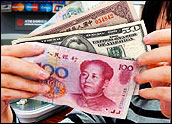
Complicating the global financial crisis are many potential short and long-term impacts on B2B markets, particularly in the market where my own operations are based, China. From one perspective, the crisis could turn out to have been a good thing for small businesses, forcing them to become more efficient and adaptive, and thus better placed to be successful in the long term.
Over the last three decades, China has based its economic model on being “the factory of the world,” and as average annual growth of 10 percent in that period shows, it has enjoyed considerable success as a result. However, in late 2008, when the world went into financial meltdown, it was clear that its factory would have some serious readjustments to make.
Recalling those months in late 2008 when the global economy was in freefall still causes a rush of blood to the head. With markets plunging, trade reduced to almost nothing and companies — from minnows to big fish — going bust by the thousand, they were hair-raising times for any small business owner.
We are far from out of the woods, but enough time has elapsed to start thinking about what lessons can be learned from the crisis and, more importantly, how to take advantage of new situations in the global economy to build stronger, more dynamic B2B markets
Wake-Up Call
In China, the crisis can be read as a wake-up call for small businesses — particularly those engaged in international trade. It is often said that China has been the major short-term beneficiary of the shift in global economic power, but to turn this into sustained competitive advantage requires fundamental changes in our B2B markets.
The crisis has demonstrated that companies need to increase the efficiency of their operations, place a greater emphasis on customer retention (this means improving customer service and developing competencies such as CRM), and become more innovative and adaptive in order to meet the challenges of the modern global B2B marketplace.
An examination of two of the most common sources of inefficiency in Chinese B2B markets illuminates some lessons of the crisis: First, use of technology is limited, and supply chains are often managed in traditional ways that fail to take advantage of modern practices and opportunities. Second, many companies prefer to replicate rather than innovate, offering cheap imitations of existing goods rather than original or exciting products.
Crucially, these fundamental problems were obscured in the boom years of the early 2000s, when international buyers were plentiful and overheads were negligible. The crisis saw international demand bottom out, however, and the rising cost of materials, labor and operating costs in China means profit margins are also being squeezed on the supply-side.
For Chinese retailers, there are two obvious responses to this pincer attack on their business models. The first is to achieve a better balance of domestic and international customers. While international markets will clearly remain hugely important for Chinese suppliers, levels of disposable income are rising in the country, making domestic markets increasingly viable for businesses.
However, the more profound challenge will be evolving a new type of Chinese B2B business — efficient, flexible and innovative. This, clearly, involves major changes in business practices and cultures, such as the faster uptake of new technologies, the evolution of an ethos of creative excellence, and more skilled staff capable of adding value at all stages of the supply chain.
The Next Level
We are witnessing the emergence of a new generation of more nimble, adaptive online traders. Our international buyers are demanding more flexible services, such as payment systems that allow them to mitigate risk by placing a higher number of smaller orders. Meanwhile, Chinese vendors are working harder on distinguishing themselves from their competitors, and there is a growing ethos of customer service.
Another benefit of a having a secure payment system integrated into the platform is that it takes B2B e-commerce to the next level. The online platform is no longer just a source of information, but a place to actually trade online. This allows a more complete, trust-based relationship to build up between buyer and seller, something that should ultimately add value for both parties over time.
There is now no doubt that the consumer boom fueled by cheap credit, which was responsible for a good deal of pre-crisis economic growth, was unsustainable. In the post-crisis B2B marketplace, both in China and beyond, the emphasis for small businesses will undoubtedly turn to boosting performance and finding new ways to add value.
These were changes that were going to have to be made at some stage — the events of the last three years have only served to increase the urgency with which businesses will make them. The view on the ground is that in China’s B2B markets, at least, this process is already well under way — and I, for one, am excited about the new opportunities it presents.
Diane Wang is the president and CEO of DHgate.com, an e-commerce platform that enables small businesses to source products directly from China.














































Social Media
See all Social Media